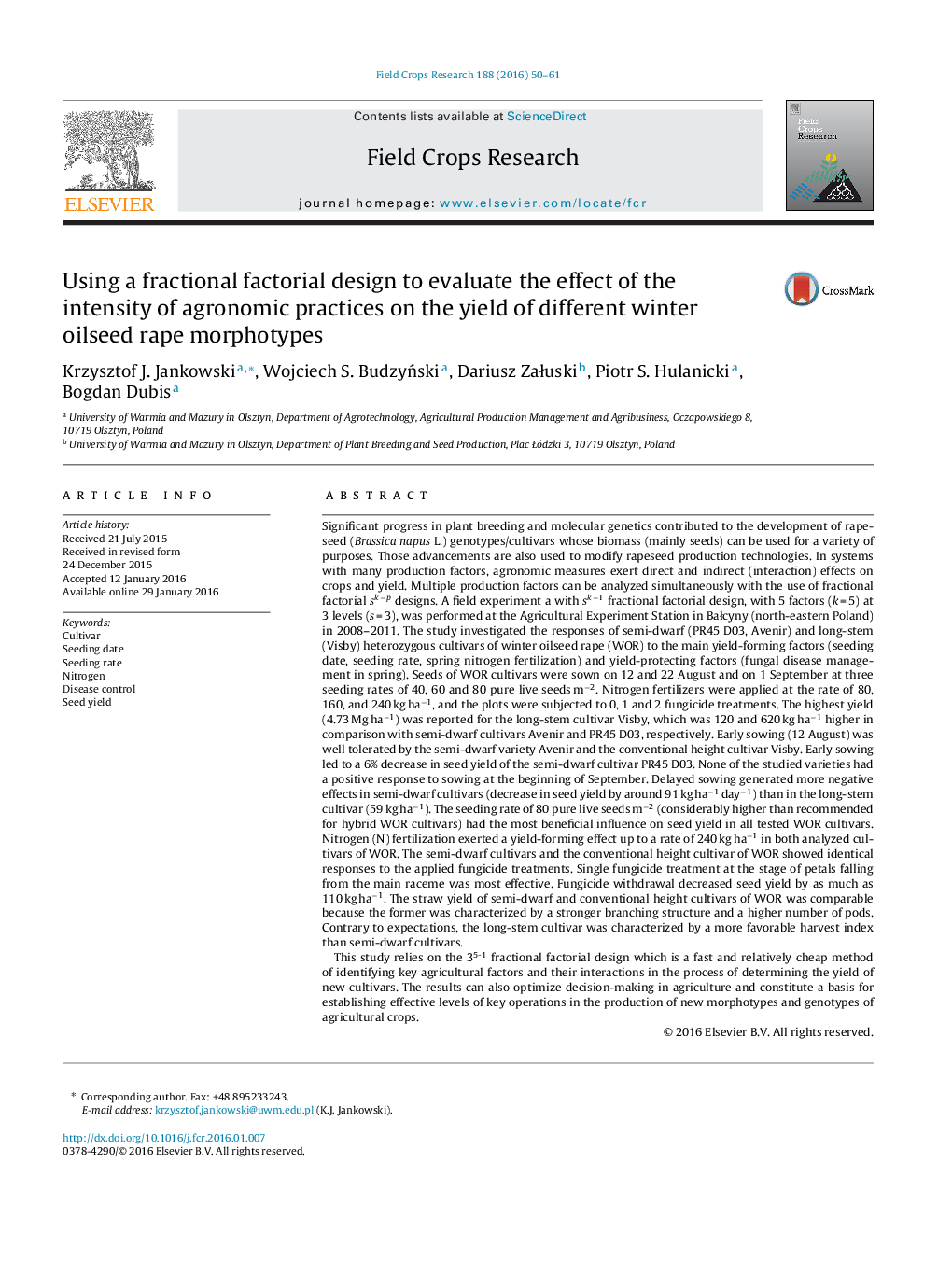| کد مقاله | کد نشریه | سال انتشار | مقاله انگلیسی | نسخه تمام متن |
|---|---|---|---|---|
| 4509846 | 1624675 | 2016 | 12 صفحه PDF | دانلود رایگان |
• Experiments with fractional factorial design support quick analyses of growth requirements in new cultivars.
• The yield of semi-dwarf cultivars was 3–13% lower in comparison with the long-stem cultivar.
• Delayed sowing decreased the seed yield of semi-dwarf cultivars.
• Both morphotypes delivered highest yields at a seeding rate of 80 pure live seeds m−2.
• Nitrogen fertilization at 240 kg ha−1 N exerted a yield-forming effect in both morphotypes.
• The analyzed morphotypes of winter oilseed rape responded similarly to the applied disease control measures.
Significant progress in plant breeding and molecular genetics contributed to the development of rapeseed (Brassica napus L.) genotypes/cultivars whose biomass (mainly seeds) can be used for a variety of purposes. Those advancements are also used to modify rapeseed production technologies. In systems with many production factors, agronomic measures exert direct and indirect (interaction) effects on crops and yield. Multiple production factors can be analyzed simultaneously with the use of fractional factorial sk−p designs. A field experiment a with sk−1 fractional factorial design, with 5 factors (k = 5) at 3 levels (s = 3), was performed at the Agricultural Experiment Station in Bałcyny (north-eastern Poland) in 2008–2011. The study investigated the responses of semi-dwarf (PR45 D03, Avenir) and long-stem (Visby) heterozygous cultivars of winter oilseed rape (WOR) to the main yield-forming factors (seeding date, seeding rate, spring nitrogen fertilization) and yield-protecting factors (fungal disease management in spring). Seeds of WOR cultivars were sown on 12 and 22 August and on 1 September at three seeding rates of 40, 60 and 80 pure live seeds m−2. Nitrogen fertilizers were applied at the rate of 80, 160, and 240 kg ha−1, and the plots were subjected to 0, 1 and 2 fungicide treatments. The highest yield (4.73 Mg ha−1) was reported for the long-stem cultivar Visby, which was 120 and 620 kg ha−1 higher in comparison with semi-dwarf cultivars Avenir and PR45 D03, respectively. Early sowing (12 August) was well tolerated by the semi-dwarf variety Avenir and the conventional height cultivar Visby. Early sowing led to a 6% decrease in seed yield of the semi-dwarf cultivar PR45 D03. None of the studied varieties had a positive response to sowing at the beginning of September. Delayed sowing generated more negative effects in semi-dwarf cultivars (decrease in seed yield by around 91 kg ha−1 day−1) than in the long-stem cultivar (59 kg ha−1). The seeding rate of 80 pure live seeds m−2 (considerably higher than recommended for hybrid WOR cultivars) had the most beneficial influence on seed yield in all tested WOR cultivars. Nitrogen (N) fertilization exerted a yield-forming effect up to a rate of 240 kg ha−1 in both analyzed cultivars of WOR. The semi-dwarf cultivars and the conventional height cultivar of WOR showed identical responses to the applied fungicide treatments. Single fungicide treatment at the stage of petals falling from the main raceme was most effective. Fungicide withdrawal decreased seed yield by as much as 110 kg ha−1. The straw yield of semi-dwarf and conventional height cultivars of WOR was comparable because the former was characterized by a stronger branching structure and a higher number of pods. Contrary to expectations, the long-stem cultivar was characterized by a more favorable harvest index than semi-dwarf cultivars.This study relies on the 35-1 fractional factorial design which is a fast and relatively cheap method of identifying key agricultural factors and their interactions in the process of determining the yield of new cultivars. The results can also optimize decision-making in agriculture and constitute a basis for establishing effective levels of key operations in the production of new morphotypes and genotypes of agricultural crops.
Journal: Field Crops Research - Volume 188, 1 March 2016, Pages 50–61
